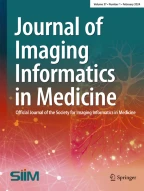Abstract
The main goal of this study was to determine the reproducibility of the reading of wrist trauma case radiographs using three different media: laser film, a picture archiving and communication systems (PACS) workstation, and paper with an optimized layout. The study was conducted retrospectively in 200 consecutive patients consulting at the emergency department for wrist trauma and who underwent wrist X-ray investigation using a computed radiography system. There were 82 men and 118 women. The mean age was 48.3 years (16–95 years). Our institutional review board does not require patient approval or informed consent for retrospective review of case records. The readings were made by two independent readers who analyzed the 200 patient radiographs consecutively in one session for each type of media: paper, laser film, and on a PACS dual-screen workstation. The inter-reader agreements were substantial or almost perfect, with kappa values of 0.83 (0.76–0.90) for the PACS, 0.83 (0.76–0.90) for film, and 0.80 (0.72–0.87) for paper. The inter-technique agreement was almost perfect in all cases. There is a high interobserver agreement between PACS, laser film, and paper readings for wrist trauma cases. With a layout of one radiograph on each sheet, paper could replace laser films to communicate the results of wrist radiographs in trauma cases for outpatients.
Similar content being viewed by others
References
Reiner BI, Siegel EL, Hooper FJ: Accuracy of interpretation of CT scans: comparing PACS monitor displays and hard-copy images. AJR Am J Roentgenol 179(6):1407–1410, 2002
Roos JE, Chilla B, Zanetti M, et al: MRI of meniscal lesions: soft-copy (PACS) and hard-copy evaluation versus reviewer experience. AJR Am J Roentgenol 186(3):786–790, 2006
Reiner BI, Siegel EL, Flagle C, et al: Effect of filmless imaging on the utilization of radiologic services. Radiology 215(1):163–167, 2000
Blum A, Sauer B, Detreille R, et al: The diagnosis of recent scaphoid fractures: review of the literature. J Radiol 88(5 Pt 2):741–759, 2007
Roberts C: Modelling patterns of agreement for nominal scales. Stat Med 27(6):810–830, 2008
Weatherburn G, Bryan S, Nicholas A, et al: The effect of a picture archiving and communications system (PACS) on diagnostic performance in the accident and emergency department. J Accid Emerg Med 17(3):180–184, 2000
Hilsenrath PE, Smith WL, Berbaum KS, et al: Analysis of the cost-effectiveness of PACS. AJR Am J Roentgenol 156(1):177–180, 1991
Khaliq W, Blakeley CJ, Maheshwaran S, et al: Comparison of a PACS workstation with laser hard copies for detecting scaphoid fractures in the emergency department. J Digit Imaging 23(1):100–103, 2010
Kundel HL, Polansky M, Dalinka MK, et al: Reliability of soft-copy versus hard-copy interpretation of emergency department radiographs: a prototype study. AJR Am J Roentgenol 177(3):525–528, 2001
Youmans DC, Don S, Hildebolt C, et al: Skeletal surveys for child abuse: comparison of interpretation using digitized images and screen-film radiographs. AJR Am J Roentgenol 171(5):1415–1419, 1998
Juenemann S, Hasler C, Brunner R: Digital imaging data on CD-R: a time trap for orthopaedic surgeons in outpatient clinics. J Child Orthop 3(1):59–62, 2009
Dreyer KJ: Need for image, data portability opens door for electronic answers. Diagn Imaging 7:1–3, 2010. April
Denslow S: Desktop publishing and medical imaging: paper as hardcopy medium for digital images. J Digit Imaging 7(3):140–145, 1994
Lyttkens K, Kirkhorn T, Kehler M, et al: Evaluation of the image quality of ink-jet printed paper copies of digital chest radiographs as compared with film: a receiver operating characteristic study. J Digit Imaging 7(2):61–68, 1994
Ibbott GS, Zhang Y, Mohiuddin M, et al: Reproduction of radiologic images on plain paper. Radiographics 18(3):755–760, 1998
Bley TA, Kotter E, Saueressig U, et al: Using receiver operating characteristic methodology to evaluate the diagnostic quality of radiography on paper prints versus film. AJR Am J Roentgenol 181(6):1487–1490, 2003
Bley T, Burger D, Ghanem N, et al: Image quality of paper prints compared to film copies in CT investigations. Rofo 174(4):423–425, 2002
Liang Z, Du X, Guo X, et al: Comparison of dry laser printer versus paper printer in full-field digital mammography. Acta Radiol 51(3):235–239, 2010
Schueller G, Kaindl E, Matzek WK, et al: Image quality of a wet laser printer versus a paper printer for full-field digital mammograms. AJR Am J Roentgenol 186(1):38–43, 2006
Doyle AJ, Le Fevre J, Anderson GD: Personal computer versus workstation display: observer performance in detection of wrist fractures on digital radiographs. Radiology 237(3):872–877, 2005
Khalid M, Jummani ZR, Kanagaraj K, et al: Role of MRI in the diagnosis of clinically suspected scaphoid fracture: analysis of 611 consecutive cases and literature review. Emerg Med J 27(4):266–269, 2010
Tiel-van Buul MM, van Beek EJ, Borm JJ, et al: The value of radiographs and bone scintigraphy in suspected scaphoid fracture. A statistical analysis. J Hand Surg Br 18(3):403–406, 1993
Ottenin MA, Jacquot A, Grospretre O, et al: Evaluation of the diagnostic performance of tomosynthesis in fractures of the wrist. AJR Am J Roentgenol 198(1):180–186, 2012
Author information
Authors and Affiliations
Corresponding author
Rights and permissions
About this article
Cite this article
Teixeira, P., Zabel, JP., Baumann, C. et al. Can Paper Replace Laser Film to Communicate the Results of Wrist Radiographs in Trauma Cases? A Reproducibility Study of the Reading of Wrist Trauma Case Radiographs on a PACS Workstation, Laser Film, and Paper. J Digit Imaging 26, 1013–1019 (2013). https://doi.org/10.1007/s10278-013-9613-8
Published:
Issue Date:
DOI: https://doi.org/10.1007/s10278-013-9613-8
